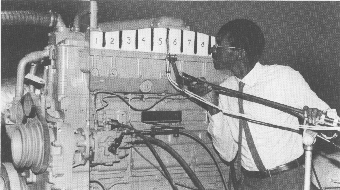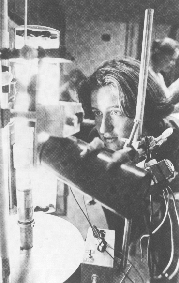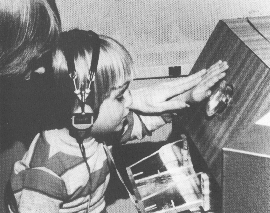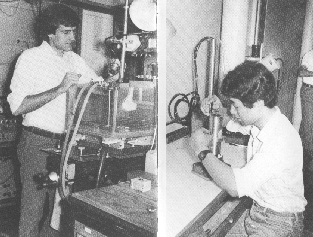Acoustics is the science of sound. It relates to recorded music, to speech and hearing, to the behavior of sound in concert halls and buildings, and to noise in our environment. Sound waves are used in medical diagnosis, for testing critical materials, and for locating fish in the ocean or oil-bearing rock formations underground. It has many branches.
Architectural acoustics deals with sound in and around buildings of all kinds. Good acoustical design ensures the efficient distribution of desirable sounds as well as the exclusion of undesirable sound. It is the branch of acoustics that comes most readily to mind when a layperson thinks of "acoustics."
Nearly everyone is aware of the importance of good acoustical design in concert halls, recording studios, auditoriums, and churches. But people spend more of their time in homes, offices, factories, or classrooms where little or no attention may have been given to the acoustical environment. Good acoustics should, and can, be engineered during the design of the building, since changes at a later time are expensive.
Growing public awareness of the importance of good acoustical design in buildings of all types will lead to a greater need for acoustical specialists and greater emphasis on acoustics in the training of architects, engineers, and other building professionals.
Engineering acoustics deals with transducers and sound measuring instruments of all kinds. A transducer is a device that converts sound energy into some other type of energy or vice versa. A microphone converts sound energy into electrical energy, a loudspeaker converts electrical energy into sound energy.
Engineering acoustics also includes instrumentation for medical diagnosis, communications, seismic surveying, recording and reproducing speech and music, and other challenging problems.
Most universities do not offer a degree specifically in acoustical engineering, but professionals in engineering acoustics may have degrees in electrical, mechanical, or aeronautical engineering, physics, or related areas. Engineers with training and experience in acoustics are very much in demand in industry.
Electroacoustics is a branch of engineering acoustics that deals with microphones, loudspeakers, and other transducers, as well as the recording and reproduction of sound.
In Europe there are special courses to prepare a person for the position of "tonmeister," one who is trained in both music and engineering. In this country such a person might be called an "audio engineer" or a "musical engineer" and the position might be that of "recording director" or "technical director." Needless to say, these positions are very much sought after. A strong preparation in music, acoustics, and electronics is necessary. Most entrants into the professional audio field begin as audio technicians to gain the necessary experience.
Persons who combine a solid background in acoustics with education or experience in business are very much in demand in the rapidly growing audio entertainment industry. A candidate is well advised to include courses in digital electronics, and computer programming because of the growing importance of digital sound processing and recoding in the audio field.
Musical acoustics deals with the way in which we hear and perceive musical sound, the instruments that produce it, and even the structure of melody and harmony. It combines elements of both the arts and science.
A number of researchers in this area study the way in which sound is produced in musical instruments. Others study subjective qualities of musical sound, such as pitch, loudness, and timbre. Much attention has focused recently on the use of digital computers to produce sound and to compose music.
Persons with training and experience in musical acoustics frequently work in the entertainment industry, in education, in recording and film studios, or in the musical instrument industry. It is a rewarding field for someone with a strong interest in music as well as in science.
Noise has been receiving increasing recognition as one of our critical environmental pollution problems. Like air and water pollution, noise pollution increases with population density. In our urban areas, it is a serious threat to the quality of life. Noise-induced hearing loss is a major health problem. Noise also robs us of sleep and interferes with communication.
Solving a noise problem requires an understanding of the noise source, the path of the sound, and the receiver (usually a person or group of people). The best place to control noise is at the source, but frequently control of the path and protection of the receiver are necessary as well.
Finding technical solutions to our environmental noise problems requires the work of scientists and engineers with considerable knowledge of acoustics. Since many problems require political or social action, knowledge of political science, sociology, and the law are important as well.
Physical Acoustics deals with the way in which sound waves propagate in solids, liquids, gases, and plasmas, and how they interact with these materials. Of special interest are sound waves of very high frequency (more that one billion vibrations per second) and very high intensity. High-frequency sound waves in solids are called phonons because they behave like particles. At temperatures near absolute zero, scientists have observed some strange waves that are called "second sound," "third sound," etc. Observing their behavior has helped physicists understand the quantum behavior of liquids.
Subatomic particles, such as protons, muons, and even the elusive neutrino, have been detected by the sound they make as they travel at high speeds through the ocean.
Many new frontiers exist in this exciting field of research. Most researchers have advanced degrees in physics.
The ability to communicate by spoken language is unique to man. We tend to take speech communication for granted, yet many aspects of it all still not completely understood. Some speech scientists are engaged in basic studies of speech production and perception, while others design machines that recognize verbal messages or individual speakers. Research that seeks to understand how man produces and perceives speech is leading to the development of methods for improved communication between man and machine and for more effective training and technical aids for those with disorders of communication.
Of equal importance is a better understanding of hearing. Our ability to perceive and appreciate the sounds around us is essential, both for our survival and for our pleasure. Although we have learned much from past research about the capabilities of the auditory system, much remains to be discovered about its underlying physiological and psychological mechanisms. Scientists interested in hearing are currently studying the peripheral ear, the neural pathway to the brain, and higher-order processing of acoustic information. Potential benefits of this research include improved transmission of acoustic signals for use by man, more effective procedures to detect abnormal development of hearing in children, and meaningful guidelines for the protection of hearing in an increasingly noisy environment.
The use of acoustic energy to "see" or detect objects underwater is analogous to the use of radar for detecting objects in air. In much the same way that an aircraft is guided through a blinding storm by its radar system, underwater vessels such as submarine are guided through the depths of the ocean by their acoustic systems.
Since the characteristics of the water environment permit sound to be transmitted over very long distances, sometimes hundreds of miles, sound is an extremely valuable tool, not only for military applications but also for commercial use. Acoustic signals are used to detect the presence and location of commercially valuable fish, to map the sea floor to determine the safest "avenues" for supertankers, and to explore the Earth's geological formations or search for oil deposits beneath the ocean floor.
The need for technological advancements in underwater acoustics will continue to grow over the next decade as man attempts to utilize the sea to the fullest advantage. This growth will afford many rewarding job opportunities for graduates in acoustics.
Bioacoustics deals with the interaction of sound waves with biological tissues in humans and animals. Much recent research in this area has been concerned with the use of high-frequency ultrasound in medical diagnosis and treatment. Use of ultrasound in diagnosis avoids some of the danger involved in using x rays and other types of radiation.
Some bioacousticians study the mechanisms by which animals produce acoustic signals and the ways in which other animals detect and process these signals. Dolphins, bats, and certain species of insects have been widely studied.
Excellent career opportunities exist in this interdisciplinary field for students with an interest in biology and medical science as well as in acoustics and physics.
Vibration is a principal concern of engineers. Large machines must be designed such that their operation is "smooth," without unwanted vibration. Electronic components of aerospace systems can be damaged by excessive vibration and sudden jolts (mechanical shocks), but a clever engineer can put basic scientific principles to work to discover ways of either eliminating the possibility of such vibration or of isolating sensitive equipment from its vibrating environment. Many "disasters," such as the destruction of a building by an earthquake, the toppling of a tall smokestack, or the collapse of a suspension bridge in a windstorm, involve vibration, but engineers are continuing to learn new ways of lessening the chance of these disasters taking place.
Since unwanted noise is often caused by vibration, when one seeks to control noise at its source, the problem often reduces to eliminating or altering vibration. There are also a multitude of applications where vibration is essential, such as in stringed and percussion instruments, in the design of loudspeakers, in the testing of metallic parts for flaws, in the transporting of very hot metal parts on moving and vibrating conveyor belts, and in the removal of dirt and soot from surfaces.
Solving a vibration problem often requires the detective skill of a Sherlock Holmes to get to the root of the problem. Not only is the mathematics involved often very sophisticated, but it also requires a great deal of common sense and ingenuity to express the real world situation in terms of mathematical relations that can yield useful insights. Since such skills and abilities are in great demand, many vibration engineers are active as consultants, giving advice to other engineers to help solve their vibration problems. (From ASA Wbesite)












